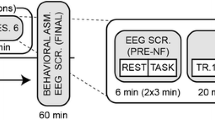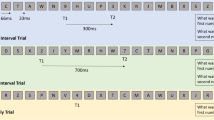Abstract
Mindfulness meditation (MM) and EEG-alpha neurofeedback (NFB) have both been shown to improve attentional performance and increase full 8–12-Hz EEG alpha amplitude, but no studies have compared MM and NFB on their effects for modulating EEG alpha or attentional control. Sixty-one university students were randomized to a 15-min single-session MM (n = 24), NFB (n = 17), or sham-NFB (SHAM; n = 20) intervention and were compared on EEG alpha full and sub-band amplitudes during completion of a single 15-min session of either intervention across 5 successive 3-min epochs, as well as during performance of the Stroop test. MM and NFB participants demonstrated higher global full-band alpha amplitude when compared with SHAM participants during the final intervention epoch, whereas no group differences were observed for sub-band amplitudes. In the absence of group differences in behavioral performance, MM participants exhibited a lower ERD of the upper alpha-band within frontal cortex 200–400 ms post-stimulus on the Stroop task, an effect that correlated with upper alpha amplitudes demonstrated during the intervention. Future research directions are discussed.



Similar content being viewed by others
References
Aftanas, L. I., & Goloshekin, S. A. (2003). Changes in cortical activity in altered states of consciousness: the study of meditation by high-resolution EEG. Human Physiology, 28(2), 143–151.
Angelakis, E., Stathopoulou, S., Frymiare, J. L., Green, D. L., Lubar, J. F., & Kounios, J. (2007). EEG neurofeedback: a brief overview and an example of peak alpha frequency training for cognitive enhancement in the elderly. Clinical Neuropsychology, 21, 110–129.
Arch, J. J., & Craske, M. G. (2006). Mechanisms of mindfulness: emotion regulation following a focused breathing induction. Beahviour Research and Therapy, 44, 1849–1858.
Baer, R. A., Smith, G. T., Hopkins, J., Krietemeyer, J., & Toney, L. (2006). Using self-report assessment methods to explore facets of mindfulness. Assessment, 13, 27–45.
Bazanova, O. M., Verevkin, E. G., & Shtark, M. B. (2007). Biofeedback in optimizing psychomotor reactivity II: the dynamics of segmental alpha-activity characteristics. Human Physiology, 33(6), 695–700.
Cahn, B. R., & Polich, J. (2006). Meditation states and traits: EEG, ERP, and neuroimaging studies. Psychological Bulletin, 132, 180–211.
Chan, D., & Woollacott, M. (2007). Effects of level of meditation experience on attentional focus: is the efficiency of executive or orientation networks improved? Journal of Alternative and Complementary Medicine, 13, 651–657.
Chiesa, A., & Serretti, A. (2010). A systematic review of neurobiological and clinical features of mindfulness meditations. Psychological Medicine, 40, 1239–1525.
Cooper, N. R., Croft, R. J., Dominey, S. J. J., Burgess, A. P., & Gruzelier, J. H. (2003). Paradox lost? Exploring the role of alpha oscillations during externally vs. internally directed attention and the implication for idling and inhibition hypotheses. International Journal of Psychophysiology, 47, 65–74.
Curran, S. L., Andrykowski, M. A., & Studts, J. L. (1995). Short form of the profile of mood states (POMS-SF): psychometric information. Psychological Assessment, 7(1), 80–83.
Dekker, M. K. J., Sitskoorn, M. M., Denissen, A. J. M., & van Boxtel, G. J. M. (2014). The time-course of alpha neurofeedback training effects in healthy participants. Biological Psychology, 95, 70–73.
Delorme, A., & Makeig, S. (2004). EEGLAB: an open source toolbox for analysis of single-trial EEG dynamics including independent component analysis. Journal of Neuroscience Methods, 134, 9–21.
Demos, J. N. (2005). Getting started with neurofeedback (p. 79). New York: W.W. Norton & Company, Inc.
Eberth, J., & Sedlmeier, P. (2012). The effect of mindfulness meditation: a meta-analysis. Mindfulness, 3, 174–189.
Egner, T., & Gruzelier, J. H. (2004). EEG Biofeedback of low beta band components: frequency-specific effects on variables of attention and event-related brain potentials. Clinical Neurophysiology, 115, 131–139.
Ergenoglu, T. (2004). Alpha rhythm of the EEG modulates visual detection performance in humans. Brain Research. Cognitive Brain Research, 20(3), 376–383.
Frewen, P. A., Evans, E. M., Maraj, N., Dozois, D. J. A., & Partridge, K. (2008). Letting go: mindfulness and negative automatic thinking. Cognitive Therapy and Research, 32, 758–774.
Frewen, P. A., Lundberg, E., MacKinley, J., & Wrath, A. (2011). Mindfulness, 2, 254–269.
Frewen, P. A., Unholzer, F., Logie-Hagan, K. R. J., & MacKinley, J. D. (2014). Meditation breath attention scores (MBAS): test-retest reliability and sensitivity to repeated practice. Mindfulness, 5(2), 161–169.
Haegens, S., Cousijn, H., Wallis, G., Harrison, P. J., & Nobre, A. C. (2014). Inter- and intra-individual variability in alpha peak frequency. NeuroImage, 92, 46–55.
Hafenbrack, A. C., et al. (2014). Debiasing the mind through meditation: mindfulness and the sunk-cost bias. Psychological Science, 25(2), 369–376.
Hanslmayr, S., Sauseng, P., Doppelmayr, M., Schabus, M., & Klimesch, W. (2005). Increasing individual upper alpha power by neurofeedback improves cognitive performance in human subjects. Applied Psychophysiology and Biofeedback, 30(1), 1–10.
Hanslmayr, S., Pastotter, B., Bauml, K. H., Gruber, S., Wimber, M., & Klimesch, W. (2008). The electrophysiological dynamics of interference during Stroop task. Journal of Cognitive Neuroscience, 20, 215–225.
Hardstone, R., Poil, S.-S., Schiavone, G., Nikulin, V. V., Mansvelder, H. D., & Linkenkaer-Hansen, K. (2012). Detrended fluctuation analysis: a scale-free view on neuronal oscillations. Frontiers in Physiology, 3, 450.
Ilan, A. B., & Polich, J. (1999). P300 and response time from a manual Stroop task. Clinical Neurophysiology, 110, 367–373.
Kindt, M., Bierman, D., & Brosschot, J. F. (1996). Stroop versus Stroop: comparison of a card format and a single-trial format of the standard color-word Stroop task and the emotional Stroop task. Personality and Individual Differences, 21, 653–661.
Klimesch, W. (1999). EEG alpha and theta oscillations reflect cognitive and memory performance: a review and analysis. Brain Research Reviews, 29, 169–195.
Klimesch, W., Sauseng, P., & Hanslmayr, S. (2007). EEG alpha oscillations: the inhibition-timing hypothesis. Brain Research Reviews, 52, 63–88.
Konareva, I. N. (2005). Modifications of the EEG frequency pattern in humans related to a single neurofeedback session. Neurophysiology, 37, 388–395.
Lagapolous, J., et al. (2009). Increased theta and alpha EEG activity during nondirective meditation. The Journal of Alternative and Complementary Medicine, 15(11), 1187–1192.
Lau, M., Bishop, S. R., Segal, Z. V., Buis, T., Anderson, N. D., Carlson, L., Shapiro, S., Carmody, J., Abbey, S., & Devins, G. (2006). The Toronto mindfulness scale: development and validation. Journal of Clinical Psychology, 62, 1445–1467.
Liotti, M., Woldorff, M. G., Perez, R., & Mayberg, H. S. (2000). An ERP study of the temporal course of the Stroop color-word interference effect. Neuropsychologia, 38, 701–711.
Lomas, T., Ivtzan, I., & Fu, C. H. Y. (2015). A systematic review of the neurophysiology of mindfulness on EEG oscillations. Neuroscience & Biobehavioral Reviews, 57, 401–410.
Lovibond, P. F., & Lovibond, S. H. (1995). The structure of negative emotional states: comparison of the Depression Anxiety Stress Scales (DASS) with the Beck Depression and Anxiety Inventories. Behaviour Research and Therapy, 33, 335–343.
Lutz, A., Slagter, H. A., Dunne, J. D., & Davidson, R. J. (2008). Attention regulation and monitoring in meditation. Trends in Cognitive Sciences, 12(4), 163–169.
Lutz, A., Slagter, H. A., Rawlings, N. B., Francis, A. D., Greischar, L. L., & Davidson, R. J. (2009). Mental training enhances attentional stability: neural and behavioural evidence. The Journal of Neuroscience, 29, 13418–13427.
McNair, D. M., Lorr, M., & Droppleman, L. F. (1971). EITS manual for the profile of mood states. San Diego: Educational and Industrial Testing Service.
Moore, A., & Mailnowski, P. (2009). Meditation, mindfulness, and cognitive flexibility. Consciousness and Cognition, 18, 176–186.
Pfurtscheller, G., & Lopes da Silva, F. H. (1999). Event-related EEG/MEG synchronization and desynchronization: basic principles. Clinical Neurophysiology, 110, 1842–1857.
Raymond, K., Varney, C., Parkinson, L. A., & Gruzelier, J. H. (2005). The effects of alpha/theta neurofeedback on personality and mood. Cognitive Brain Research, 23, 287–292.
Romero, S. G., McFarland, D. J., Faust, R., Farrell, L., & Cacace, A. T. (2008). Electrophysiological markers of skill-related neuroplasticity. Biological Psychology, 78, 221–230.
Ros, T., Théberge, J., Frewen, P. A., Kluetsch, R., Densmore, M., Calhoun, V. D., & Lanius, R. A. (2013). Mind over chatter: plastic up-regulation of the fMRI salience network directly after EEG neurofeedback. NeuroImage, 15, 324–335.
Salo, R., Henik, A., & Robertson, L. C. (2001). Interpreting Stroop interference: an analysis of differences between task versions. Neuropsychology, 15, 462–471.
Sedlmeier, P., Eberth, J., Schwarz, M., Zimmerman, D., Haarig, F., & Kunze, S. (2012). The psychological effects of meditation: a meta-analysis. Psychological Bulletin, 138, 1139–1171.
Slagter, H. A., Lutz, A., Greischar, L. L., Francis, A. D., Nieuwenhuis, S., Davis, J. M., & Davidson, R. J. (2007). Mental training affects distribution of limited brain resources. PLoS Biology, 5(6), 1228–1236.
Slagter, H. A., Davidson, R. J., & Lutz, A. (2011). Mental training as a tool in the neuroscientific study of brain and cognitive plasticity. Frontiers in Human Neuroscience, 5, 17.
Tang, Y., Ma, Y., Wang, J., Fan, Y., Feng, S., Lu, Q., et al. (2007). Short-term meditation training improves attention and self-regulation. Proceedings of the National Academy of the Sciences, 104, 17152–17156.
van Boxtel, G. J. M., Denissen, A. J. M., Jager, M., Vernon, D., Dekker, M. J. K., & Sitskoorn, M. M. (2012). A novel self-guided approach to alpha activity. International Journal of Psychophysiology, 83, 282–294.
van Lutterveld, R., Houlihan, S. D., Pal, P., Sacchet, M. D., McFarlane-Blake, C., & Brewer, J. D. (2016). Source-space EEG neurofeedback links subjective experience with brain activity during effortless awareness meditation. NeuroImage. doi:10.1016/j.nueorimage.2016.02.047.
Vernon, D., Dempster, T., Bazanova, O., Rutterford, N., Pasqualini, M., & Andersen, S. (2009). Alpha neurofeedback training for performance enhancement: reviewing the methodology. Journal of Neurotherapy, 13, 214–227.
Wenk-Sormaz, H. (2005). Meditation can reduce habitual responding. Advances, 21, 33–49.
Zoefel, B., Huster, R. J., & Herrmann, C. S. (2011). Neurofeedback training of the upper alpha frequency band in EEG improves cognitive performance. NeuroImage, 54, 1427–1431.
Author information
Authors and Affiliations
Corresponding author
Ethics declarations
Funding
This study was funded by the Ontario Mental Health Foundation and the Lawson Health Research Institute.
Conflict of Interest
The authors declare that they have no conflict of interest.
Ethical Approval
All procedures performed in studies involving human participants were in accordance with the ethical standards of the institutional and/or national research committee and with the 1964 Helsinki Declaration and its later amendments or comparable ethical standards.
Electronic supplementary material
Below is the link to the electronic supplementary material.
Fig. S1
(JPG 105 kb)
Rights and permissions
About this article
Cite this article
Chow, T., Javan, T., Ros, T. et al. EEG Dynamics of Mindfulness Meditation Versus Alpha Neurofeedback: a Sham-Controlled Study. Mindfulness 8, 572–584 (2017). https://doi.org/10.1007/s12671-016-0631-8
Published:
Issue Date:
DOI: https://doi.org/10.1007/s12671-016-0631-8




